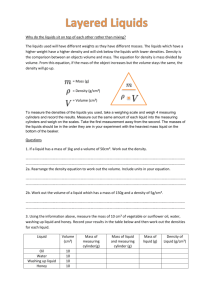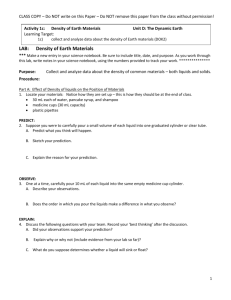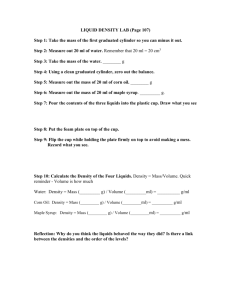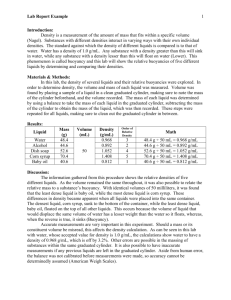Density Column - TJHSST Activities
advertisement
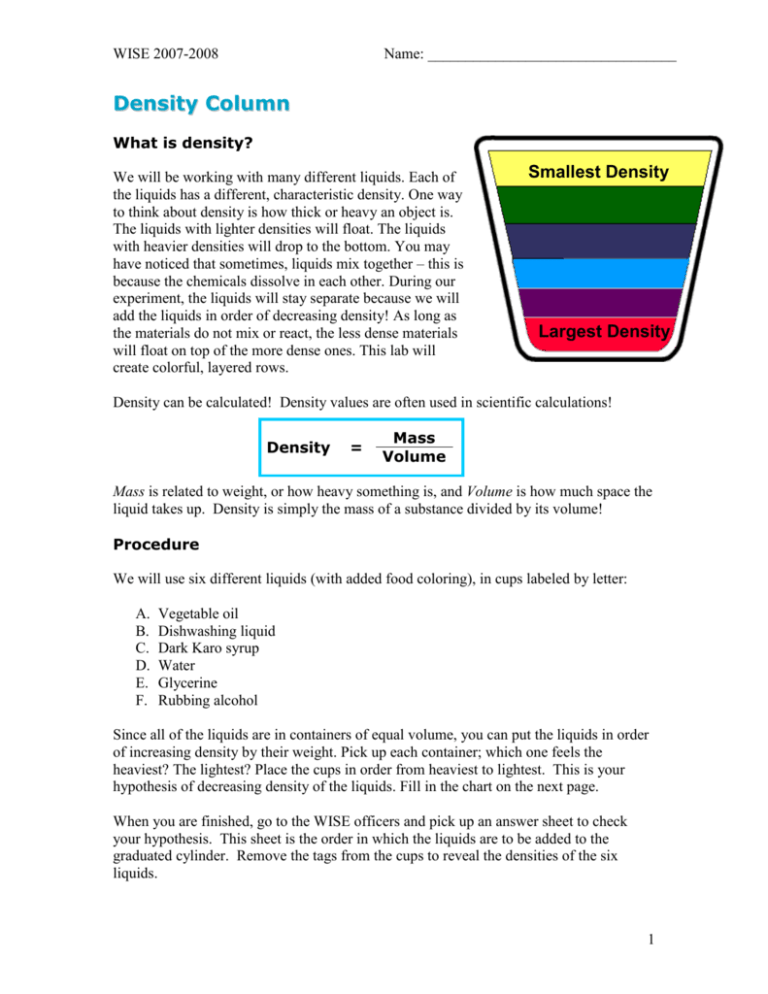
WISE 2007-2008 Name: _________________________________ Density Column What is density? We will be working with many different liquids. Each of the liquids has a different, characteristic density. One way to think about density is how thick or heavy an object is. The liquids with lighter densities will float. The liquids with heavier densities will drop to the bottom. You may have noticed that sometimes, liquids mix together – this is because the chemicals dissolve in each other. During our experiment, the liquids will stay separate because we will add the liquids in order of decreasing density! As long as the materials do not mix or react, the less dense materials will float on top of the more dense ones. This lab will create colorful, layered rows. Smallest Density Largest Density Density can be calculated! Density values are often used in scientific calculations! Density = Mass Volume Mass is related to weight, or how heavy something is, and Volume is how much space the liquid takes up. Density is simply the mass of a substance divided by its volume! Procedure We will use six different liquids (with added food coloring), in cups labeled by letter: A. B. C. D. E. F. Vegetable oil Dishwashing liquid Dark Karo syrup Water Glycerine Rubbing alcohol Since all of the liquids are in containers of equal volume, you can put the liquids in order of increasing density by their weight. Pick up each container; which one feels the heaviest? The lightest? Place the cups in order from heaviest to lightest. This is your hypothesis of decreasing density of the liquids. Fill in the chart on the next page. When you are finished, go to the WISE officers and pick up an answer sheet to check your hypothesis. This sheet is the order in which the liquids are to be added to the graduated cylinder. Remove the tags from the cups to reveal the densities of the six liquids. 1 WISE 2007-2008 Liquid Letter Name: _________________________________ Liquid Name Liquid Weight Heaviest … … … … Lightest Liquid Density Most dense DO NOT pour along the sides! Pour along sides of the cylinder Pour along sides of the cylinder Pour along sides of the cylinder Pour along sides of the cylinder Least dense Now you are ready to add your liquids to the graduated cylinder! Add them according to the order in your chart. Pour the most dense first, avoiding the sides of the graduated cylinder. The remaining liquids are to be poured along the sides to avoid mixing. You should have a colorful band of liquids! Now, we can compare the densities of the liquids to the densities of solids! You can test the relative densities of the solids provided based on where they land in the container when dropped (gently). Your station should have five different solids: Solid Hypothesis: Density Rank (most dense is #1) Density Rank after test Lead pellet Rubber stopper Oak Cork Candle wax Pick up each of the solids. Discuss the density of each item at the table. Rank the items from the greatest density to the lowest density. In the chart above, label each solid #1 to #5, with #1 being the most dense. Hypothesize as to what will happen to the solid when added to the density column. Where will your solid float? What does this tell you about its density? Now carefully drop each of the solids into the density column, from the most dense to the least dense. Was your hypothesis correct? Fill In The Blank If a solid floats on top of all of the liquids, it is the most / least (circle one) dense. If a solid drops to the bottom, it is the most / least (circle one) dense. What do you think about solids that stay suspended in the middle? 2 WISE 2007-2008 Name: _________________________________ When you are completely finished, here are the calculated densities of the materials used: Are the liquids in your graduated cylinder in this order? Densities: (from top to bottom; units = g/mL) 1. Cork – 0.2 2. Alcohol – 0.79 3. Oak – 0.8 4. Vegetable oil – 0.9 5. Water – 1.0 6. Dishwashing liquid – 1.03 7. Rubber – 1.2 8. Glycerine – 1.26 9. Dark Karo syrup – 1.37 10. Lead – 11.9 When you are completely finished, here are the calculated densities of the materials used: Are the liquids in your graduated cylinder in this order? Densities: (from top to bottom; units = g/mL) 1. Cork – 0.2 2. Alcohol – 0.79 3. Oak – 0.8 4. Vegetable oil – 0.9 5. Water – 1.0 6. Dishwashing liquid – 1.03 7. Rubber – 1.2 8. Glycerine – 1.26 9. Dark Karo syrup – 1.37 10. Lead – 11.9 3
